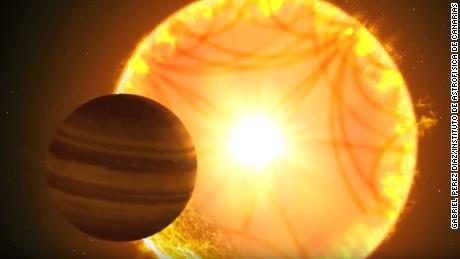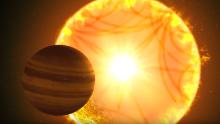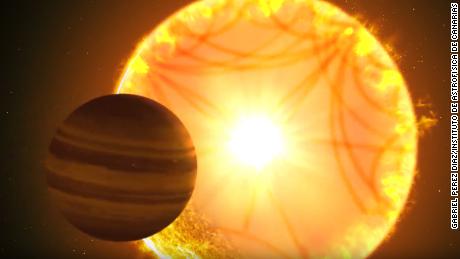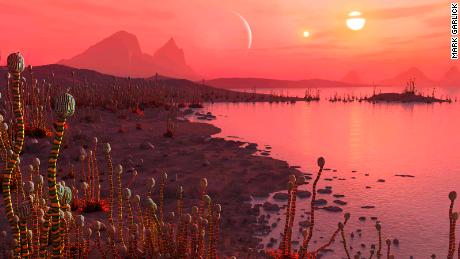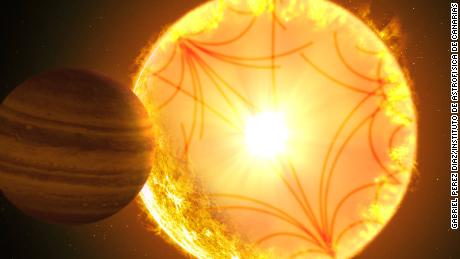“It’s so exciting that TESS, which launched just about a year ago, is already a game-changer in the planet-hunting business,” Johanna Teske, author of a study describing the planets and Hubble Postdoctoral Fellow at the Carnegie Institution for Science, said in a statement. “The spacecraft surveys the sky and we collaborate with the TESS follow-up community to flag potentially interesting targets for additional observations using ground-based telescopes and instruments.”
The Earth-size planet, dubbed HD 21749c, completes an orbit of its host star every eight days. Its planetary sibling, HD 21749b, is about 23 times Earth’s mass and has a radius about 2.7 times that of Earth. This puts the exoplanet in the category of a sub-Neptune or mini-Neptune.
The study was published in The Astrophysical Journal Letters on Monday.
Researchers determined that the density suggests that the mini-Neptune has a substantial atmosphere. But it’s not a rocky planet, like Earth, which could make for insightful followup observations about how the atmosphere is composed and its evolution.
The star that both planets orbit has the equivalent of 80% of our sun’s mass.
Most of the exoplanets TESS will find are expected to have orbital periods of 10 days or less. The mini-Neptune was an exciting find for researchers because of its orbital period of 36 days.
This made the discovery more challenging. The researchers used the Planet Finder Spectrograph on the Magellan II telescope at Las Campanas Observatory in Chile to confirm that the signals picked up by TESS were planets. This device also measured the mass of the mini-Neptune.
Mass is key for exoplanet discovery because it enables the determination of density or even chemical composition.
“There was quite some detective work involved, and the right people were there at the right time,” said Diana Dragomir, lead study author and Hubble Fellow at the Massachusetts Institute of Technology’s Kavli Institute for Astrophysics and Space Research, in a statement. “But we were lucky, and we caught the signals, and they were really clear.”
The researchers hope to learn more about the Earth-size planet, as well.
“Measuring the exact mass and composition of such a small planet will be challenging, but important for comparing HD 21749c to Earth,” said Sharon Wang, study author and Carnegie Institution for Science postdoctoral fellow, in a statement. “Carnegie’s [Planet Finder Spectrograph] team is continuing to collect data on this object with this goal in mind.”
TESS will look for exoplanets using the transit method, observing slight dips in stars’ brightness as planets pass in front of them. Bright stars allow for easier followup study through ground- and space-based telescopes.
NASA expects TESS to allow for the cataloging of more than 1,500 exoplanets, but it has the potential to find thousands. Of these, officials anticipate, 300 will be Earth-size exoplanets or double-Earth-size super Earths. Those planets could be the best candidates for supporting life outside our solar system. Like Earth, they are small, rocky and usually within the habitable zones of their stars, meaning liquid water can exist on the surface.
TESS is considered a “bridge to the future,” finding exoplanet candidates to study in more detail.
These exoplanets will be studied so NASA can determine the best targets for missions like the James Webb Space Telescope. That telescope, launching in 2021, would be able to characterize the details and atmospheres of exoplanets in ways scientists have not been able to do.
But TESS will also help researchers measure mass and maybe even the composition of planetary atmospheres.
“For stars that are very close by and very bright, we expected to find up to a couple dozen Earth-sized planets,” Dragomir said. “And here we are — this would be our first one, and it’s a milestone for TESS. It sets the path for finding smaller planets around even smaller stars, and those planets may potentially be habitable.”
Views: 332


